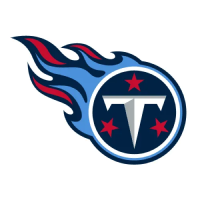I’m still not certain on whether or not Notre Dame running back Kyren Williams is going to have a resume that commands being a first-round pick next April. There are so many data points that need to be filled out—typically your first-round running backs these days come in the form of 4.3 athletes like Travis Etienne or 300-carry bell cows like Najee Harris. And that’s what makes Williams such a unique study.
I don’t think he’s either one of those things. But I do absolutely believe after the first few weeks in 2021 that Williams is the best running back prospect eligible for the 2022 NFL Draft.
His most recent credited height and weight are 5-foot-8 and 200 pounds. He’s likely going to run high 4.4s at the absolute best. But damn it, sometimes the tape doesn’t lie. And when I watch Williams on film, I see a player who offers every bit of a skill set needed to keep the narratives about positional value and depreciation at the running back position at bay.
Williams isn’t just a running back, he’s a three-down player who contributes in the passing game in more ways than one. He’s well versed in the receiving game—both as a player who gets targets on swing routes and working out of the backfield, but also as a player who gets flexed into the slot.
That’s exactly how his number was called this past Saturday against Purdue, when Notre Dame quickly broke the huddle in an empty set and isolated Williams in space on 4th-and-3. And when the play was all said and done, Williams had taken the quick throw in stride and ran to the end zone, putting Notre Dame ahead for a lead they’d never surrender. Williams has, for his career, caught 47 passes for 471 yards and three scores in fewer than 20 games played.
But you can find receiving backs in plenty of places, right? Nyheim Hines just got $6 million per season from Indianapolis at No. 104 overall in 2018. James White has made a killing with the Patriots as a receiving back and he was drafted at No. 130 overall in 2014. What makes Williams a different prospect than those receiving specialists?
This is where Williams’ tape gets rather fun: his pass protection skills are excellent. For my money, Williams’ ability to scan, ID, and stick defenders in pass protection are top-shelf. And as the great Daniel Jeremiah points out, backs who can protect on a weekly basis with consistency are a critical component to the modern offensive demands facing backfield players.
https://twitter.com/MoveTheSticks/status/1439955180489822222
You won’t often find Williams catching “Ls” in pass pro—and that’s the dividing factor for me that really sets him up to be the top running back in this year’s class. Yes, you read that right. Blocking in the passing game is one of Williams’ hallmark traits and a dividing variable between him and many of his contemporaries.
If running backs are going to survive the latest trend in NFL spending, which is seeing tight ends challenge the financial status of running backs on account of an ability to impact both the passing game and the run game, they’re going to need backs like Williams to have a big presence in the next few years. I definitely think Williams has the DNA needed to hold that kind of presence in an offensive backfield.
Rewind to last year’s showing in the Irish’s upset against Clemson for a marquee example. Against one of the best defensive coordinators in college football, Williams was flawless in pass protection, as outlined by Cameron Soran.
https://twitter.com/cameronsoran/status/1327459045066739712
This simply isn’t a one-game aberration, either. Williams, although he did admittedly start slow to open last season against Duke in dealing with first contact, was an absolute stud in protection all around last season.
His continued assertiveness and fearlessness of attacking in protection, despite not being a bigger back, simply leap off the screen at you.
https://twitter.com/GrindingTheTape/status/1398811112716517379
All of this before we even get into Williams’ ability to make explosive plays happen with the ball in his hands. In three games this season against Florida State, Toledo, and Purdue, Williams has logged at least one 40-yard play in each game:
- A 55-yard reception against Florida State
- A 43-yard touchdown run against Toledo
- A 51-yard game-breaking touchdown against Purdue in the final mark to push the Irish’s lead to 14
Williams is no stranger to big plays. He tagged Duke for a 75-yard reception, Florida State and Clemson for 65-yard rushes, and North Carolina for a 47-yard gainer in 2020, too. So when you mix all the variables together, it is hard to not get excited about what Williams offers as an all-around player.
As NFL teams continue to push their tight ends out into space to help the passing game, running backs are going to continue to bear the burden of being the sixth man in protection schemes more often than not. The appeal with running back usage extends beyond just having them fill the void left by the evolution of the tight end position, too—there’s the fact that running backs can see more unfolding in the front and should theoretically be able to take on more diverse assignments to help counter blitz pressures as compared to a traditional tight end playing in-line on the line of scrimmage.
So consider Williams’ modest physical stature relative to his colleagues in the backfield and try to take it at face value, if you can. And after that sinks in, watch Williams execute the skills that we’re seeing running backs being tasked with in today’s style of play in the NFL. And then, after you’ve sprinkled in his vision and big-play instinct as a ball carrier, try to tell me he doesn’t have a strong case for RB1.
Go ahead. Change my mind.
Filed In
Related Articles
NFL Draft
Arik Gilbert Doesn’t Need Big Workload To Be A Top NFL Draft Pick
- Aug 22, 2022
NFL Draft
2023 NFL Mock Draft: Marino 1.0
- Aug 22, 2022
Written By


































